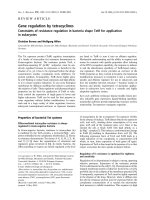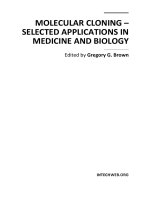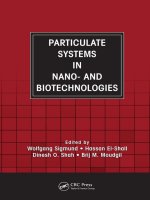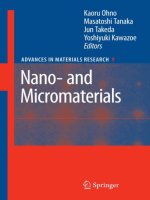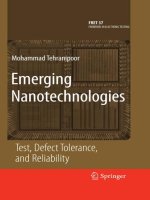- Trang chủ >>
- Khoa Học Tự Nhiên >>
- Vật lý
nanomaterials for application in medicine and biology, 2008, p.201
Bạn đang xem bản rút gọn của tài liệu. Xem và tải ngay bản đầy đủ của tài liệu tại đây (6.66 MB, 201 trang )
Nanomaterials for Application in Medicine
and Biology
NATO Science for Peace and Security Series
This Series presents the results of scientifi c meetings supported under the NATO Programme:
Science for Peace and Security (SPS).
The NATO SPS Programme supports meetings in the following Key Priority areas: (1) Defence
Against Terrorism; (2) Countering other Threats to Security and (3) NATO, Partner and Mediter-
ranean Dialogue Country Priorities. The types of meeting supported are generally "Advanced
Study Institutes" and "Advanced Research Workshops". The NATO SPS Series collects
together the results of these meetings. The meetings are coorganized by scientists from NATO
countries and scientists from NATO's "Partner" or "Mediterranean Dialogue" countries. The
observations and recommendations made at the meetings, as well as the contents of the volumes
in the Series, refl ect those of participants and contributors only; they should not necessarily be
regarded as refl ecting NATO views or policy.
Advanced Study Institutes (ASI) are high-level tutorial courses intended to convey the
latest developments in a subject to an advanced-level audience
Advanced Research Workshops (ARW) are expert meetings where an intense but informal
exchange of views at the frontiers of a subject aims at identifying directions for future action
Following a transformation of the programme in 2006 the Series has been re-named and
re-organised. Recent volumes on topics not related to security, which result from meetings
supported under the programme earlier, may be found in the NATO Science Series.
The Series is published by IOS Press, Amsterdam, and Springer, Dordrecht, in conjunction with
the NATO Public Diplomacy Division.
Sub-Series
A. Chemistry and Biology Springer
B. Physics and Biophysics Springer
C. Environmental Security Springer
D. Information and Communication Security IOS Press
E. Human and Societal Dynamics IOS Press
/>
Series B: Physics and Biophysics
Nanomaterials
for Application in Medicine
and Biology
edited by
Michael Giersig
center of advanced european studies and research (caesar)
Bonn, Germany
and
Gennady B. Khomutov
Moscow State University
Moscow, Russia
Proceedings of the NATO Advanced Research Workshop on
Nanomaterials for Application in Medicine and Biology
Bonn, Germany
4–6 October 2006
A C.I.P. Catalogue record for this book is available from the Library of Congress.
ISBN 978-1-4020-6828-7 (PB)
ISBN 978-1-4020-6827-0 (HB)
ISBN 978-1-4020-6829-4 (e-book)
Published by Springer,
P.O. Box 17, 3300 AA Dordrecht, The Netherlands.
www.springer.com
Printed on acid-free paper
All Rights Reserved
© 2008 Springer Science + Business Media B.V.
No part of this work may be reproduced, stored in a retrieval system, or transmitted
in any form-or by any means, electronic, mechanical, photocopying, microfilming,
recording or otherwise, without written permission from the Publisher, with the
exception of any material supplied specifically for the purpose of being entered and
executed on a computer system, for exclusive use by the purchaser of the work.
CONTENTS
Preface vii
Contributors ix
1. Biocompatible Nanomaterials and Nanodevices Promising
for Biomedical Applications 1
I. Firkowska, S. Giannona, J. A. Rojas-Chapana,
K. Luecke, O. Brüstle, and M. Giersig
2. Isohelical DNA-Binding Oligomers: Antiviral Activity
and Application for the Design of Nanostructured Devices 17
G. Gursky, A. Nikitin, A. Surovaya, S. Grokhovsky,
V. Andronova, and G. Galegov
3. DNA Self-Assembling Nanostructures Induced by Trivalent Ions
and Polycations 29
N. Kasyanenko and D. Afanasieva
4. DNA-Based Synthesis and Assembly of Organized Iron Oxide
Nanostructures 39
G. B. Khomutov
5. DNA-Based Nanostructures: Changes of Mechanical
Properties of DNA upon Ligand Binding 59
Y. Nechipurenko, S. Grokhovsky, G. Gursky,
D. Nechipurenko, and R. Polozov
6. Nanoconstructions Based on Spatially Ordered Nucleic
Acid Molecules 69
Yu. M. Yevdokimov
7. Nanospearing – Biomolecule Delivery and Its
Biocompatibility 81
D. Cai, K. Kempa, Z. Ren, D. Carnahan, and T. C. Chiles
8. Multifunctional Glyconanoparticles: Applications in Biology
and Biomedicine 93
S. Penadés, J. M. de la Fuente, Á. G. Barrientos, C. Clavel,
O. Martínez-Ávila, and D. Alcántara
v
9. Plasmonics of Gold Nanorods. Considerations
for Biosensing 103
L. M. Liz-Marzán, J. Pérez-Juste, and I. Pastoriza-Santos
10. Influence of the S-Au Bond Strength on the Magnetic
Behavior of S-Capped Au Nanoparticles 113
M. J. Rodríguez Vázquez, J. Rivas, M. A. López-Quintela,
A. Mouriño Mosquera, and M. Torneiro
11. Long-Term Retention of Fluorescent Quantum
Dots In Vivo 127
B. Ballou, L. A. Ernst, S. Andreko, M. P. Bruchez,
B. C. Lagerholm, and A. S. Waggoner
12. Towards Polymer-Based Capsules with Drastically
Reduced Controlled Permeability 139
D. V. Andreeva and G. B. Sukhorukov
13. Polyelectrolyte-Mediated Transport of Doxorubicin
Through the Bilayer Lipid Membrane 149
A. A. Yaroslavov, M. V. Kitaeva, N. S. Melik-Nubarov,
and F. M. Menger
14. Network Model of Acetobacter Xylinum Cellulose
Intercalated by Drug Nanoparticles 165
V. V. Klechkovskaya, V. V. Volkov, E. V. Shtykova,
N. A. Arkharova, Y. G. Baklagina, A. K. Khripunov,
R. Yu. Smyslov, L. N. Borovikova, and A. A. Tkachenko
15. Theoretical Approaches to Nanoparticles 179
K. Kempa
vi Contents
PREFACE
This volume contains research reports presented during the NATO Advanced
Research Workshop (ARW) “Materials for Application in Medicine and
Biology” held in Bonn, Germany, from October 4 to 6, 2006 at the center
of advanced european studies and research (caesar).
The application of nanomaterials in medicine and biology can be understood
as the gathering and use of our current knowledge on nanoscale features of bio-
logical systems in order to learn how to design nanodevices for biomedical uses.
The success of this approach, known as nano-engineering, will allow scientists
to devise strategies for the design and construction of nanodevices to be used in
clinical trials (diagnosis and therapeutic monitoring), as well as to develop
products with potential applications in regenerative medicine.
One goal of this conference was to bring together researchers from Eastern
and Western countries, offering them a platform to meet and discuss results of
their research work. Thus, the aim of this conference was not only to present the
advancements in research achieved during the past years, but it had also been
conceived as a concerted European effort where expertise, technologies, and
ideas were broadly shared to accelerate this progress. The conference provided
an interactive forum with more than 100 participants from 15 countries.
The 15 selected papers cover the following topics: (1) nanodevices for
biomedical applications; (2) DNA-nanoparticle conjugates; (3) transmem-
brane delivery of macromolecules by nanomaterials and/or polyelectrolytes;
(4) glyconanoparticles for biomedical purposes; (5) optical properties of gold
nanoparticles and biosensing; (6) magnetic behavior of S-capped gold nano-
particles; (7) quantum dots for biological tagging; (8) polymer-based cap-
sules; (9) theoretical approaches to nanoparticles.
The conference was organized by the Department of Nanoparticle
Technology at the center of advanced european studies and research (caesar),
with Professor Dr. Giersig as head-organizer, and Professor Dr. Khomutov
from Moscow State University as co-organizer, in full cooperation with
caesar, and generous financial support by NATO.
We would especially like to thank the NATO Science Programme for
providing a generous grant for the realization of this conference. We would
also like to acknowledge and thank all those who participated in this event
including those who provided expertise through the presentation of their
research as well as everyone who engaged in discussions and contributed to
the organization and planning of the conference – in short, all who helped
to make the NATO Advanced Research Workshop 2006 a success.
vii
CONTRIBUTORS
Daria Afanasieva
Dept. of Molecular Biophysics, Faculty of Physics,
St. Petersburg State University, Uluanovskaya St. 1, Petrodvorets, St.
Petersburg, 198504, Russia
David Alcántara
Laboratory of Glyconanotechnology, CIC biomaGUNE and
CIBER-BBN Networking Centre on Bioengineering, Biomaterials
and Nanomedicine, Paseo Miramón 182, Parque Tecnológico
de San Sebastián, 20009 San Sebastián, Spain
Daria V. Andreeva
Max Planck Institute of Colloids and Interfaces, Am Muehlenberg 1,
14476 Golm/Potsdam, Germany
Susan Andreko
Molecular Biosensor and Imaging Center, Mellon Institute, Carnegie
Mellon University, 4400 Fifth Avenue, Pittsburgh, PA 15213, USA
Valeria Andronova
D.I. Ivanovsky Institute of Virology, Russian Academy of Medical
Sciences, Gamaleya Str. 16, Moscow, 123098, Russia
Natalia A. Arkharova
Institute of Crystallography, Russian Academy of Sciences,
Leninsky pr. 59, Moscow, 119333, Russia
Yulia G. Baklagina
Institute of Macromolecular Compounds, Russian Academy of
Sciences, Bolshoi pr. 31, St. Petersburg, 199004, Russia
Byron Ballou
Molecular Biosensor and Imaging Center/Department of Biological
Sciences, Mellon Institute, Carnegie Mellon University, 4400 Fifth
Avenue, Pittsburgh, PA 15213, USA
ix
África G. Barrientos
Laboratory of Glyconanotechnology, CIC biomaGUNE and
CIBER-BBN Networking Centre on Bioengineering, Biomaterials
and Nanomedicine, Paseo Miramón 182, Parque Tecnológico
de San Sebastián, 20009 San Sebastián, Spain
Ludmila N. Borovikova
Institute of Macromolecular Compounds, Russian Academy of
Sciences, Bolshoi pr. 31, St. Petersburg, 199004, Russia
Marcel P. Bruchez
Molecular Biosensor and Imaging Center/Department of Chemistry,
Mellon Institute, Carnegie Mellon University, 4400 Fifth Avenue,
Pittsburgh, PA 15213, USA
Oliver Brüstle
Institute of Reconstructive Neurobiology, Life and Brain Center,
University of Bonn, Sigmund-Freud-Str. 25, 53127 Bonn,
Germany
Dong Cai
Department of Biology, Boston College, 140 Commonwealth Avenue,
Chestnut Hill, MA 02467, USA/NanoLab, Inc., Newton, MA 02458,
USA
David Carnahan
NanoLab, Inc., Newton, MA 02458, USA
Thomas C. Chiles
Department of Biology, Boston College, 140 Commonwealth Avenue,
Chestnut Hill, MA 02467, USA
Caroline Clavel
Laboratory of Glyconanotechnology, CIC biomaGUNE and
CIBER-BBN Networking Centre on Bioengineering, Biomaterials
and Nanomedicine, Paseo Miramón 182, Parque Tecnológico
de San Sebastián, 20009 San Sebastián, Spain
Lauren A. Ernst
Molecular Biosensor and Imaging Center, Mellon Institute, Carnegie
Mellon University, 4400 Fifth Avenue, Pittsburgh, PA 15213, USA
x Contributors
Izabela Firkowska
center of advanced european studies and research (caesar),
Nanoparticle Technology Dept., Ludwig-Erhard-Allee 2,
53175 Bonn, Germany
Jesus M. de la Fuente
Laboratory of Glyconanotechnology, CIC biomaGUNE and
CIBER-BBN Networking Centre on Bioengineering, Biomaterials
and Nanomedicine, Paseo Miramón 182, Parque Tecnológico
de San Sebastián, 20009 San Sebastián, Spain
Georgy Galegov
D.I. Ivanovsky Institute of Virology, Russian Academy of Medical
Sciences, Gamaleya Str. 16, Moscow, 123098, Russia
Suna Giannona
center of advanced european studies and research (caesar),
Nanoparticle Technology Dept., Ludwig-Erhard-Allee 2,
53175 Bonn, Germany
Michael Giersig
center of advanced european studies and research (caesar),
Nanoparticle Technology Dept., Ludwig-Erhard-Allee 2,
53175 Bonn, Germany
Sergey Grokhovsky
V.A. Engelhardt Institute of Molecular Biology, Russian Academy
of Sciences, Vavilov Str. 32, Moscow, 119991, Russia
Georgy Gursky
V.A. Engelhardt Institute of Molecular Biology, Russian Academy
of Sciences, Vavilov Str. 32, Moscow, 119991, Russia
Nina Kasyanenko
Dept. of Molecular Biophysics, Faculty of Physics, St. Petersburg
State University, Uluanovskaya St. 1, Petrodvorets, St. Petersburg,
198504, Russia
Krzysztof Kempa
Department of Physics, Boston College, 140 Commonwealth Avenue,
Chestnut Hill, MA 02467, USA
Contributors xi
Gennady B. Khomutov
Faculty of Physics, Moscow State University, Leninskie Gory 1,
119992 Moscow, Russia
Albert K. Khripunov
Institute of Macromolecular Compounds, Russian Academy of
Sciences, Bolshoi pr. 31, St. Petersburg, 199004, Russia
Marina V. Kitaeva
School of Chemistry, M.V. Lomonosov Moscow State University,
Leninskie Gory, Moscow, 119899, Russia
Vera V. Klechkovskaya
Institute of Crystallography, Russian Academy of Sciences,
Leninsky pr. 59, Moscow, 119333, Russia
B. Christoffer Lagerholm
Molecular Biosensor and Imaging Center, Mellon Institute,
Carnegie Mellon University, 4400 Fifth Avenue, Pittsburgh,
PA 15213, USA
Present address: Memphys, Physics Department, University
of Southern Denmark, Campusvej 55, 5230 Odense, Denmark
Luis M. Liz-Marzán
Departamento de Química Física, and Unidad Asociada
CSIC- Universidade de Vigo, 36310 Vigo, Spain
M. Arturo López-Quintela
Laboratory of Magnetism and Nanotechnology, Institute of
Technological Research, Departments of Physical Chemistry
and Applied Physics, University of Santiago de Compostela,
Edificio da Imprenta, 15782 Santiago de Compostela, Spain
Klaus Luecke
GILUPI Nanomedicine GmbH, Am Muehlenberg 11, 14476 Golm,
Germany
Olga Martínez-Ávila
Laboratory of Glyconanotechnology, CIC biomaGUNE and
CIBER-BBN Networking Centre on Bioengineering, Biomaterials
and Nanomedicine, Paseo Miramón 182, Parque Tecnológico
de San Sebastián, 20009 San Sebastián, Spain
xii Contributors
Nikolay S. Melik-Nubarov
School of Chemistry, M.V. Lomonosov Moscow State University,
Leninskie Gory, Moscow, 119899, Russia
Frederic M. Menger
Department of Chemistry, Emory University, Atlanta, GA 30322,
USA
Antonio Mouriño Mosquera
Department of Organic Chemistry, CSIC Associated Unit,
University of Santiago de Compostela, Spain
Dmitry Nechipurenko
Department of Physics, Moscow State University, Leninskie Gory,
Moscow, 119992, Russia
Yury Nechipurenko
Engelhardt Institute of Molecular Biology, Russian Academy
of Sciences, Vavilov Str. 32, Moscow, 119991, Russia
Alexei Nikitin
V.A. Engelhardt Institute of Molecular Biology, Russian Academy
of Sciences, Vavilov Str. 32, Moscow, 119991, Russia
Isabel Pastoriza-Santos
Departamento de Química Física, and Unidad Asociada CSIC-
Universidade de Vigo, 36310 Vigo, Spain
Soledad Penadés
Laboratory of Glyconanotechnology, CIC biomaGUNE and
CIBER-BBN Networking Centre on Bioengineering, Biomaterials
and Nanomedicine, Paseo Miramón 182, Parque Tecnológico
de San Sebastián, 20009 San Sebastián, Spain
Jorge Pérez-Juste
Departamento de Química Física, and Unidad Asociada CSIC-
Universidade de Vigo, 36310 Vigo, Spain
Robert Polozov
Institute for Theoretical and Experimental Biophysics, Moscow
Region, Instituskaya Str. 3, Puschino, 142290, Russia
Contributors xiii
Zhifeng Ren
Department of Physics, Boston College, Chestnut Hill, MA 02467,
USA
José Rivas
Laboratory of Magnetism and Nanotechnology, Institute of
Technological Research, Departments of Physical Chemistry
and Applied Physics, University of Santiago de Compostela,
Edificio da Imprenta, 15782 Santiago de Compostela, Spain
María J. Rodríguez Vázquez
Laboratory of Magnetism and Nanotechnology, Institute of
Technological Research, Departments of Physical Chemistry and
Applied Physics, University of Santiago de Compostela, Edificio da
Imprenta, 15782 Santiago de Compostela, Spain
José A. Rojas-Chapana
center of advanced european studies and research (caesar),
Nanoparticle Technology Dept., Ludwig-Erhard-Allee 2, 53175 Bonn,
Germany
Eleonora V. Shtykova
Institute of Crystallography, Russian Academy of Sciences,
Leninsky pr. 59, Moscow, 119333, Russia
Ruslan Yu. Smyslov
Institute of Macromolecular Compounds, Russian Academy
of Sciences, Bolshoi pr. 31, St. Petersburg, 199004, Russia
Gleb B. Sukhorukov
Department of Materials, Queen Mary, University of London,
Mile End Road, E1 4NS, London, United Kingdom
Anna Surovaya
V.A. Engelhardt Institute of Molecular Biology, Russian Academy
of Sciences, Vavilov Str. 32, Moscow, 119991, Russia
Albina A. Tkachenko
St. Petersburg State University, Universitetskaya nab. 7-9,
St. Petersburg, 199034, Russia
xiv Contributors
Mercedes Torneiro
Department of Organic Chemistry, CSIC Associated Unit,
University of Santiago de Compostela, Spain
Vladimir V. Volkov
Institute of Crystallography, Russian Academy of Sciences,
Leninsky pr. 59, Moscow, 119333, Russia
Alan S. Waggoner
Molecular Biosensor and Imaging Center/Department of Biological
Sciences, Mellon Institute, Carnegie Mellon University, 4400 Fifth
Avenue, Pittsburgh, PA 15213, USA
Alexander A. Yaroslavov
School of Chemistry, M.V. Lomonosov Moscow State University,
Leninskie Gory, Moscow, 119899, Russia
Yuri M. Yevdokimov
Engelhardt Institute of Molecular Biology of the Russian Academy
of Sciences, Vavilov Str. 32, Moscow, 119991, Russia
Contributors xv
M. Giersig and G. B. Khomutov (eds.), 1
Nanomaterials for Application in Medicine and Biology
© Springer Science + Business Media B.V. 2008
Biocompatible Nanomaterials and Nanodevices
Promising for Biomedical Applications
Izabela Firkowska
1
, Suna Giannona
1
, José A. Rojas-Chapana
1
,
Klaus Luecke
2
, Oliver Brüstle
3
, and Michael Giersig
1,
*
1
center of advanced european studies and research (caesar), Nanoparticle Technology
Department, Ludwig-Erhard-Allee 2, 53175 Bonn, Germany
2
GILUPI Nanomedicine GmbH, Am Muehlenberg 11, 14476 Golm, Germany
3
Institute of Reconstructive Neurobiology, Life and Brain Center, University of Bonn,
Sigmund-Freud-Str. 25, 53127 Bonn, Germany
* To whom correspondence should be addressed. E-mail:
Abstract Nanotechnology applied to biology requires a thorough understanding
of how molecules, sub-cellular entities, cells, tissues, and organs function and how
they are structured. The merging of nanomaterials and life science into hybrids
of controlled organization and function is possible, assuming that biology is
nanostructured, and therefore man-made nano-materials can structurally mimic
nature and complement each other. By taking advantage of their special properties,
nanomaterials can stimulate, respond to and interact with target cells and tissues
in controlled ways to induce desired physiological responses with a minimum of
undesirable effects. To fulfill this goal the fabrication of nano-engineered materi-
als and devices has to consider the design of natural systems. Thus, engineered
micro-nano-featured systems can be applied to biology and biomedicine to enable
new functionalities and new devices. These include, among others, nanostructured
implants providing many advantages over existing, conventional ones, nanodevices
for cell manipulation, and nanosensors that would provide reliable information on
biological processes and functions.
Keywords Nanotechnology, carbon nanotubes, gold nanoparticles, nanoporation,
tissue engineering, biosensing
1 Introduction
Nanotechnology poses a new frontier in science and technology. The essence of
nanotechnology is the ability to work at the atomic and molecular levels, to create
novel structures or devices with fundamentally new molecular organization.
2 I. Firkowska et al.
Novel materials engineered at the nanometer scale (nanomaterials) are indispensable
elements on the whole field of nanotechnology. They can be considered as the
most important crossing between basic research and marketable products and
processes. Nanomaterials show great market potential, e.g. by substituting other
materials or by making available new functionalities and thus enabling new prod-
ucts. The fact that the dimensions of nanomaterials are analogous to those of nat-
ural biological structures such as proteins and DNA allows for the direct
integration of nanomaterials into biological systems. Last, it offers a platform for
the emerging research field of bio-nanotechnology. Bio-nanotechnology can be
viewed as an attempt to reproduce cellular basic building blocks or molecular
design principles by means of highly organized structures based on nanomateri-
als. This enables scientists and engineers to create bio-inspired nanodevices with
life-science applications. This challenge requires an interdisciplinary research
effort that can be translated directly into new technologies and products for
biomedical applications.
We have recently started working with carbon nanotubes and gold nanoparticles
for their application in the field of biomedical devices. Carbon nanotubes – discov-
ered by Sumio Iijima
1
(1991) – are among the technologically most interesting
nanoscale materials currently under investigation for medical application.
2–5
Carbon
nanotubes being mechanically tough, chemically inert, and highly conductive make
them very attractive tools for bio-interfacial engineering, ultra-sensitive biosensing,
single-cell experimentation, and drug delivery.
On the other hand, arrays of noble-metal nano-islands are promising as new
platforms for low-cost and rapid biosensing. This becomes possible as a result of
changes in the electro-optical properties of the metal nanoparticles, which are
induced by simple target attachment. As a result, this class of metal nano-sensors
provided with a very sensitive biofunctionalization is able to rapidly report the pres-
ence of specific substances in a fluid or in the air. In particular, we show that peri-
odic arrays of gold nanoparticles can work as nanosensors due to the
wavelength-specific plasmonic-resonance phenomena between lights and the gold
surface.
2 Results
The following results reflect recent findings and future prospects of nanotechnology
applications in life science. The nanomaterials used have made it possible to study
interfacial phenomena encountered in biological systems. The results emerging
from these studies create an exciting focus for research in the bioengineering field.
On the other hand, recent results obtained on nanosensory include the development
of biosensing-chips for the recognition, trapping, and immobilization of rare cells
types in peripheral blood. The biosensing-chip relies on gold nano-islands com-
bined with an antigen-antibody reaction. Our ultimate goal is to design chip-sensors
for diagnostic and patient monitoring.
Nanomaterials for Biomedicine 3
2.1 Carbon Nanotubes and Nanoporation
Initial experiments probing the usefulness of nanostructures for cell manipulation
were conducted in bacterial cells. First, we demonstrated the interaction of carbon
nanotubes and silica-coated gold nanoparticles with biological membranes in
Acidothiobacillus ferrooxidans.
6
In this study we predicted that, when exposed to
short microwave-pulses, carbon nanotubes would undergo spontaneous polarization
leading to dipole-like oscillation able to disrupt the cell envelope of bacterial cells.
Published in late 2004, the prediction was later verified in experiments with DNA.
Here, we provided details of highly reproducible and facile integration of plasmids
into bacterial cells by an electromagnetic procedure based on employing nanotubes
as needle-like devices.
7
As a result, carbon nanotubes exposed to a short microwave
(mw) pulse (2–4 sec) become polarized in the direction of an electromagnetic field,
thereby interacting directly with charges on cell surfaces (see Fig. 1).
As the nanotubes remain polarized while being attached to the cell surfaces, the
membrane disrupts gradually, and thereby the particles/plasmids are physically
acted upon and subsequently incorporated into the cells. This finding opens up the
path to a new system for cell electroporation which uses nanotubes as electropora-
tive devices. Several attempts to reproduce these results on eukaryotic cells have
been unsuccessful. Transformation of Saccharomyces cerevisiae by mw-activated
carbon nanotubes resulted in transient expression of plasmid DNA, but not in a
transfer to the progeny after cell division. A similar phenomenon was observed in
mammalian cells by using plasmid DNA covalently bound to carbon nanofibres and
centrifugation.
8
We are currently working on modifying the surface of nanotubes
and nanowires to improve – under the conditions of our experiments – the nanoporation
Fig. 1 TEM images depicting an Acidothiobacillus ferrooxidans bacterium interacting with water-
dispersible multiwalled carbon nanotubes and silica-coated gold nanoparticles
4 I. Firkowska et al.
of these cells. In this context, the mechanical penetration of cell membranes by
carbon nanotubes and gene transfer under a magnetic driving field (spearing) has
been reported.
9
This technique lends itself as an alternative method for effective cell
poration and requires no time-consuming operations. Prato et al.
10
show that Hela
cells incubated in solutions containing ammonium-functionalized single-walled
carbon nanotubes and DNA increase gene expression with increasing incubation
times. Likewise, Gao et al. obtain similar results with positively charged nano-
tubes.
11
In both cases, the mechanism of cellular uptake so far remains unclear.
Kam et al. proposed an energy-dependent endocytosis mechanism for the intracel-
lular transport of carbon nanotubes and gene expression.
12
Unlike our approach, in
these three examples, cells were incubated for at least 1 h in concentrated solutions
of functionalized carbon nanotubes. Thus, each of these approaches is time-consuming
and not free from contamination with nanotubes, but a valuable source of information
describing cellular uptake of cell-penetrating carbon nanotubes.
Transient contact of cells with an array of aligned carbon nanotubes may solve
this problem. Vertically aligned nanotube arrays can be applied in multiple parallel
processes as nano-needle-chips (see Fig. 2). In this case, under a short electromag-
netic pulse or centrifugation, all aligned carbon nanotubes contacting living cells
would simultaneously position themselves across the cell membrane, thus leading
to a highly improved introduction of foreign material into cells, thereby preserving
the integrity and cleanness of the samples.
8,13
Fig. 2 SEM image showing an array of aligned carbon nanotubes intended for delivering foreign
material into cells quickly and efficiently. In this case, the nanotubes will leave the cells clean and
unharmed
Nanomaterials for Biomedicine 5
Taking into account that carbon nanotubes are hollow cylinders, they can store
active substances, thus the same nano-electroporative approach may be used
for localized drug delivery. In contrast to conventional micro-pipettes widely used for
patch-clamp electrophysiology, ionophoretic stimulation, and single-cell injections,
nanoscaled minimal-invasive nanotubes are advantageous for studies involving
gentle membrane permeabilization and subsequent ejection of molecules from the
internal lumen of a nanotube into the cytosol.
14
2.2 Carbon Nanotubes for Bone Tissue Engineering
Previously we showed that mouse fibroblast cells were able to grow onto nanopat-
terned substrates made up of intercrossed carbon nanotubes.
15
In a recent set of
experiments, we have also demonstrated that a substrate provided with a periodic
nano-pattern can significantly influence cellular behavior.
16
These results show that
highly ordered arrays of carbon nanotubes may be used for guiding and controlling
the growth of mammalian cells. On the other hand, the effects of nanoscale substrate
topography (texture and roughness) on the behavior of human cells can be explored
by substrates prepared by nanosphere lithography (NSL) combined with layer-by-
layer deposition (LBL). We possess in-depth expertise in these techniques and they
have been successfully used to prepare nanohybrids with enhanced mechanical
properties mimicking the unique features of the extracellular matrix (ECM).
17
2.2.1 Periodic Array of Aligned Carbon Nanotubes
Our current studies have focused on manipulating the growth of osteoblast-like
cells with periodic arrays of aligned carbon nanotubes.
16
This perfectly controlled
chemical environment and the spacing of these nanotubes in a nanometer range
dramatically enhance cell surface activity. Cell-culture assays on these substrates
reveal that the high number of attachment sites (nanotubes) promotes cell-attach-
ment via cell extensions much better than non-nanostructured substrates (Fig. 3).
The formation of cell extensions is closely associated with biomechanical forces
exerted by cells on individual nanotubes (Fig. 4). These interfacial reactions at the
nanoscale definitely lead to cell shape alterations and influence the direction of
their movement. To explore whether a distortion of the periodic carbon nanotube-
pattern might result in a change in the onset of cell adhesions, the wafer surface was
scratched with a diamond knife. The results show a lack of cell growth onto the
naked underlying wafer surface (Fig. 5). Similar findings have recently been
reported by Cavalcanti-Adam et al.
18
who describe the development of thin, tube-
like membrane tethers as being dependent on the surface nanopatterning and its
density. We can assume that the observed substrate preference is exclusively due to
the presence of hydrophobic carbon nanotubes. These results allow us to conclude
that osteoblast cells are able to “sense” the nano-geometry of their surrounding
6 I. Firkowska et al.
Fig. 3
SEM image depicting the growth of osteoblast-like cells on a periodic array of carbon
nanotubes. Remarkably, the cell extensions are consistent with the dimension and distribution of
aligned nanotubes
Fig. 4 SEM image depicting cell extensions of osteoblast-like cells exerting traction forces
against the nanotubes
Nanomaterials for Biomedicine 7
environment. Further, the periodic distribution of the nanotubes directly controls
how and where osteoblast-like cells will grow. Carbon nanotubes mimicking mor-
phological nano-features of the native ECM reveal new “smart tools” by which
bone cells can be patterned during development. This could be a beneficial effect
regarding tissue regeneration.
19,20
2.2.2 Fabrication of Highly Ordered Nanostructured Layers
and Their Impact on Cell Growth
As aforementioned, the NSL technique combined with the layer-by-layer (LBL)
assembly process was employed to reproduce at least partially, both the exceptional
nanotopography and nanochemistry presented on the extracellular matrix (ECM) of
bone. In particular, we aim to create architectures and topographies that mimic
native bone tissue (Fig. 6). The complete network architecture consists of succes-
sive layers of cross-linked carbon nanotubes that self-assemble into orderly struc-
tures. The method allows for controlled shaping and guarantees the considerable
chemical and mechanical stability of the self-assembled monolayers, allowing for
high reproducibility in manufacturing. The films – as free-standing substrates – are
characterized by controlled geometry, surface topography, and chemical composi-
tion.
17
The films can be impregnated with macromolecules such as collagen and
fibronectin, and dotted with bioactive materials, including hydroxyapatite and
metal nanoparticles.
To address the role of nano-sized features in complex nanostructured substrates,
both texture and surface roughness of free-standing films were tested for their ability
Fig. 5 SEM image showing the lack of growth effect by a nanotube-free area of the nanopat-
terned substrate
8 I. Firkowska et al.
to promote cell growth. Thin free-standing films are extremely interesting substrates
in examining how cell growth, proliferation, and differentiation may be controlled
by nanosized features. Therefore, the design and characterisation of bioinspired
nanoscaled-featured constructs constitute a major part of our research. In order to
design a suitable cell scaffold the following are required: carbon nanotubes as the
chosen material must be biocompatible, non-toxic, of sufficient strength to support
cell growth, geometrically appropriate and favorable to cell proliferation. Moreover,
the same scaffolds as free-standing films have to be provided with highly intercon-
nected pores to allow the diffusion of liquid medium for nutrient supply and waste
removal. Taken together, all of these properties define optimal culturing conditions.
For these experiments, osteoblast-like cells were seeded onto nanostructured
films to evaluate cell viability and proliferation. Standard tissue culture plastic was
used as a control. The results demonstrate that the cells respond to a surface nano-
topography with excellent adhesion and spreading (Fig. 7). The cells respond dif-
ferently depending on the configuration of the micro- and nanotopographical cues
present on the substrates. Furthermore, the cell patterns on the substrates reveal that
the nanotubes do influence the organization of the cells. This aspect suggests that
nanoscale biomechanics of cell attachment and migration may be steered by man-
made nanoscaled features. The latter will contribute to a better understanding of the
central role that cell mechanics plays in sensing a nanoenvironment comparable to
cell substructures. These findings offer the possibility of enhancing cell growth by
using multiple nano-architectures and various chemical and physical stimuli. This
promising approach promotes the fabrication of nanostructured substrates that can
Signal A = InLens EHT = 10.00 kV Date :18 Mar 2005 Detector = InLens 300nm*
WD = 4 mm File name = M_10_Cp_d91.tif
Stage at T = 30.0Њ
500 nm
Mag = 85.45 K X
Fig. 6 SEM image showing a bioinspired free-standing substrate made up of carbon nanotubes
arranged in a regular network of micro-cavities
Nanomaterials for Biomedicine 9
mimic the extracellular matrix so that cell adhesion, growth and proliferation can
be manipulated for future implant technologies.
21,22
2.3 Nanotechnology Approaches in Enhancing Axon
Regeneration
Though there have been a number of developments in neural prosthetics at the
nanoscale by using carbon nanotubes
23–26
and semiconductor nanoparticles,
27
the
engineering of functional and stable neural/electronic interfaces remains a crucial
research area. The major challenge for the engineering and application of neuro-
prosthetic implants constitutes the establishment of a bi-directional flow of infor-
mation between a conductive nanomaterial and the neural systems.
28,29
Based on the premise that nanostructures might influence axonal repair – the gap
between severed nerves – nanoscale-featured substrates made up of multi-walled car-
bon nanotubes and neuronal cells will be tested in collaboration with the Institute of
Reconstructive Neurobiology in Bonn. Carbon nanotubes are strong, electrically
conductive, and hollow structures of pure carbon that might conduct electrical signals
to neurons, thereby acting as a “scaffolding” device to stimulate nerve cells to elon-
gate and repair damage, and create new axons.
30,31
These new axons would take over
for the damaged ones, reconnecting with the damaged nerves’ counterparts. The elu-
cidation how these phenomena may be manipulated and exploited when carbon nano-
tubes are assembled into a neural network has not been explored yet. Carbon
nanotubes would represent a means of presenting axons with an attractive hollow
structure provided with unique conductive electrical properties, which can be used for
highly-controlled local stimulation. Much experimental work remains to be done in
this regard. Our working hypothesis is that carbon nanotube-based substrates,
Fig. 7 SEM image depicting cell growth of osteoblast-like cells on bioinspired CNT-based substrates
10 I. Firkowska et al.
provided with multiple growth-promoting cues, will induce positive stimulation of
axon regeneration. The ultimate goal behind this project is to develop nano-featured
substrates that can actively communicate with neural cells.
30,31
Initial results show
neuronal cells growing onto nanostructured substrates (Fig. 8).
2.4 Hexagonal Array of Gold Nanoparticles and Biosensing
Another component of our studies is the design of nanostructured sensor devices hav-
ing promising properties for medical diagnostics. This research is mainly focused on
the detection of metabolites by means of bioactive interfaces (nanosensors) designed
at the nanoscale. Our goal is to create minimal-invasive interfaces that allow fast diag-
nosis of organics and cells with a high specificity and sensitivity. This includes the
preparation and biofunctionalization of metal nanoparticles as detection devices. Here,
we describe a novel biosensing system that comprises biological receptor molecules
(i.e., antibodies for target recognition) attached to sensitive optical nano-transducers.
It is conceived to detect the presence of a substance on the metal surface by determin-
ing changes in light absorption in the sample. Specifically, the nanosensor is based on
the tunability of the localized surface plasmon resonance (LSPR) of arrays of noble-
metal nanoparticles.
32,33
The nanosensor operates on the principle that small changes
in the refractive index at or near a noble metal nanoparticle can be used to detect the
binding of substances at very low concentrations.
Our nanobiosensor design essentially consists of a periodic array of gold nano-
“islands” prepared by means of nanosphere lithography (NSL). The NSL uses a
sacrificial mask of polymer nanospheres for subsequent processing steps. The NSL
combined with chemical vapour deposition (CVD) results in an array of periodic
Fig. 8 SEM image depicting a bioinspired CNT-based substrate promoting the growth of neural cells
Nanomaterials for Biomedicine 11
nanostructures on a substrate (see upper part of Fig. 9). The nano-islands obtained
via this method have a width ranging from 50 to 150 nm and a thickness of ca.
10 nm (see Fig. 9). Both the size and the interparticle spacing of the gold arrays can
be tuned by the colloidal particles in the mask. Though NSL is a complex and
costly technique, one advantage of this method in its application to bio-sensing is
the high-throughput sensing and the potential of simultaneously monitoring many
targets in one substrate, which is essential in biosensing technology. In addition,
being bound to a substrate (wafer) greatly increases the efficacy of these nano-
islands for use in bio-sensing applications. However, the efficacy of the nano-islands as
nanosensors is strongly influenced or even governed by the inactivity of the surface
area around the nano-islands. The latter presupposes the avoidance of the non-specific
attachment caused by random collisions between the targets and the nanostructured
substrate. Thus, the nano-islands of the present approach are designed towards
specific interactions, and therefore to allow a specific measurement which relies
exclusively upon the special properties and periodicity of the metal nano-islands.
To address the functionalization of the gold array, we follow previously-established
procedures.
34,35
The nano-islands were provided with heterofunctional linkers, which
Fig. 9 (Upper part) Scanning electron microscope (SEM) image of an ordered array of nanopar-
ticles generated from a polystyrene nanosphere mask after gold deposition and removal of the
mask. (a) SEM micrograph displaying the typical morphology of the hexagonal array seen in the
upper image. It consists of homogeneous triangular-shaped gold nanoparticles, which, after a
sintering process, can undergo a morphological change from triangles to spheres (b)


